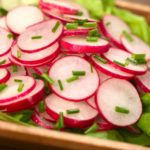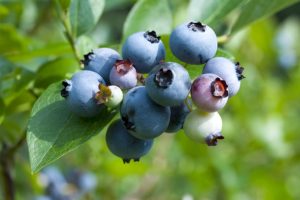
You can easily grow superfoods in your garden and quickly prepare and serve them in minutes. Superfoods are high in nutritional value and provide important chemical compounds—called phytochemicals—that fight disease and improve health.
Superfoods have been around for thousands of years, but the term has gained popularity over the past two decades. Superfoods from the garden include blueberries, broccoli, kale, spinach, tomatoes, walnuts, and more. Other superfoods include salmon, soy, green tea, turkey, and yogurt.
Superfoods, among other benefits, can lower cholesterol, reduce the risk of heart disease and cancer, and improve your mood and emotional well-being.
Most superfoods can be eaten raw out of hand though you may find a few tastier with just a bit of preparation—such as steaming or stir-frying. But, in the end, superfoods require very little kitchen time.
10 SUPERFOODS FROM THE GARDEN. (And click here to see even more Superfoods from the garden.):
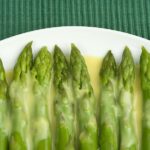 Asparagus. Asparagus can be eaten raw, parboiled, steamed, boiled, roasted, and grilled. This perennial is one of the earliest crops in spring.
Asparagus. Asparagus can be eaten raw, parboiled, steamed, boiled, roasted, and grilled. This perennial is one of the earliest crops in spring.
Asparagus is a natural diuretic.
Asparagus is high in potassium and vitamin B12, important for cell repair and maintenance. New research has also shown that B12 can boost the auditory system. People with low levels have a 39 percent increased risk of hearing loss.
→Click here for How to Grow Asparagus.
→Click here for Asparagus Kitchen Basics.
 Basil and Mint. Use basil fresh or dried to add a mild, sweet flavor to soups, salads, stews, fish, meat, and sauces. Use mint fresh or dried to flavor vegetables and add fresh mint to cold and hot soups and beverages.
Basil and Mint. Use basil fresh or dried to add a mild, sweet flavor to soups, salads, stews, fish, meat, and sauces. Use mint fresh or dried to flavor vegetables and add fresh mint to cold and hot soups and beverages.
Basil and mint aid digestion and diminish inflammation.
Basil and mint are also strong sources of luteolin, which many boost the immune system.
→Click here for How to Grow Basil.
→Click here for Basil Kitchen Basics.
→Click here for How to Grow Mint.
→Click here for Mint Kitchen Basics.
 Blueberries. Grow blueberries in a sunny location in sandy, well-drained that can stay moist. Allow 8 feet between plants. Choose rabbit-eye varieties where winters are not very cold. Grow low-bush varieties in the northeast and Canada. Grow high-bush varieties everywhere else.
Blueberries. Grow blueberries in a sunny location in sandy, well-drained that can stay moist. Allow 8 feet between plants. Choose rabbit-eye varieties where winters are not very cold. Grow low-bush varieties in the northeast and Canada. Grow high-bush varieties everywhere else.
Blueberries rank among the top disease-fighting foods; blueberries contain anthocyanin an antioxidant and anti-inflammatory that fights Alzheimer’s, Parkinson’s, diabetes, and heart disease.
A diet high in blueberries may reduce a woman’s risk of heart attack by 33 percent and stave off memory loss by several years.
→Click here for Blueberry Types and Varieties.
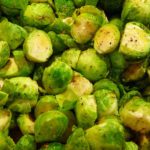 Brussels sprouts. Serve Brussels sprouts as a vegetable side dish on their own or with butter. Add Brussels sprouts to soups, stews, or stir-fries. Brussels sprouts grow best in cool weather and can even take some sub-freezing temperatures.
Brussels sprouts. Serve Brussels sprouts as a vegetable side dish on their own or with butter. Add Brussels sprouts to soups, stews, or stir-fries. Brussels sprouts grow best in cool weather and can even take some sub-freezing temperatures.
Brussels sprouts contain the chemical sinigrin which suppresses the development of precancerous cells.
Brussels sprouts are high in isothiocyanates and sulforaphane, compounds fight cancer by inhibiting cell proliferation, neutralizing carcinogens.
→Click here for How to Grow Brussels sprouts.
→Click here for Brussels sprouts Kitchen Basics.
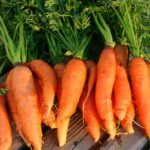 Carrots. Serve carrots raw or cooked. Allow 30 days for sweet baby carrots and 50 to 80 days to reach full size and maturity.
Carrots. Serve carrots raw or cooked. Allow 30 days for sweet baby carrots and 50 to 80 days to reach full size and maturity.
Recent studies say one carrot a day can cut the rate of lung cancer in half (first, stop smoking).
Carrots are high in carotenoids, antioxidant compounds, associated with a decrease in bladder, cervix, prostate, colon, and larynex and esophageal cancer.
Carrots are an excellent source of lutein and zeaxanthin, two carotenoids that work together to protect eye health.
Three medium carrots contain 60 mg of calcium, 586 mg of potassium, and 30,000 IUs of vitamin A.
→Click here for How to Grow Carrots.
→Click here for Carrot Kitchen Basics.
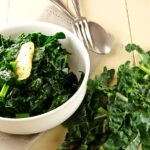 Kale. Ready from the garden in 55 to 70 days. Steam kale with butter, lemon juice, and chopped bacon.
Kale. Ready from the garden in 55 to 70 days. Steam kale with butter, lemon juice, and chopped bacon.
Kale is rich in vitamin calcium, iron, and vitamins A, C, and bone-building vitamin K.
Kale is a good source of lutein which reduces the risk of cataracts and other eye disorders; one serving of cooked kale has almost three-times the amount of lutein that a serving of raw spinach has.
Kale contains powerful phytochemicals such as breast, cervical, and colon cancer-fighting indoles.
Kale is a good source of sulfur and contains sulforaphane which helps boost the body’s detoxification enzymes.
→Click here for How to Grow Kale.
 Pomegranates. This fruit grows on a small tree or shrub. Pomegranates are long-lived but sensitive to frost in fall and spring and do not mature well in cool climates. Propagate pomegranates from cuttings.
Pomegranates. This fruit grows on a small tree or shrub. Pomegranates are long-lived but sensitive to frost in fall and spring and do not mature well in cool climates. Propagate pomegranates from cuttings.
Pomegranates contain high levels of antioxidants that help keep the cardiovascular system healthy. One 17-ounce glass of pomegranate juice every day will lower blood pressure. The antioxidant capacity of pomegranate juice is two to three times that of green tea.
→Click here for Pomegranate Kitchen Basics.
 Sweet Potatoes. Sweet potatoes are grown from rooted cuttings called “slips.” From transplanting sweet potatoes are ready for harvest in about 100 days. Serve sweet potatoes cooked; boiled and mashed sweet potatoes will be extra smooth.
Sweet Potatoes. Sweet potatoes are grown from rooted cuttings called “slips.” From transplanting sweet potatoes are ready for harvest in about 100 days. Serve sweet potatoes cooked; boiled and mashed sweet potatoes will be extra smooth.
Sweet potatoes contain vitamins A and B6 and potassium that helps protect the immune system and regulate blood pressure.
When eaten with the skins, sweet potatoes have more fiber than a cup of oatmeal.
→Click here for How to Grow Sweet Potatoes.
→Click here for Sweet Potato Kitchen Basics.
 Strawberries. Check the variety you purchase; June-bearing strawberries produce one crop a year in late spring or early summer; ever-bearing strawberries peak in early summer and then continue to bear through autumn.
Strawberries. Check the variety you purchase; June-bearing strawberries produce one crop a year in late spring or early summer; ever-bearing strawberries peak in early summer and then continue to bear through autumn.
Strawberries contain chemicals found to protect cells against cervical and breast cancer; phytochemicals in strawberries can inhibit steps in tumor initiation.
Compounds in strawberries may protect the brain from short-term memory loss.
Strawberries contain anthocyanins that can inhibit pain and inflammation signals associated with arthritis.
→Click here for Planting Strawberries.
→Click here for Strawberry Kitchen Basics.
 Thyme. Known as the “blending’ herb because it pulls flavors together. Use leaves with slow-cooked beef, pork, poultry, seafood, soups, stews, and in bouquet garni.
Thyme. Known as the “blending’ herb because it pulls flavors together. Use leaves with slow-cooked beef, pork, poultry, seafood, soups, stews, and in bouquet garni.
Thyme in tincture form can be used to fight bacteria; thyme’s fragrant oil called thymol is a powerful antiseptic, antioxidant, and anti-inflammatory agent. Use thyme to aid digestion and dislodge mucus coating of the intestinal track.
→Click here for How to Grow Thyme.
→Click here for Thyme Kitchen Basics.
 Walnuts. Grow walnuts in deep, well-drained soil. Trees can range in size from 40 to 80 feet tall and 30 to 60 feet wide. Plant two varieties to ensure fertilization and fruit set.
Walnuts. Grow walnuts in deep, well-drained soil. Trees can range in size from 40 to 80 feet tall and 30 to 60 feet wide. Plant two varieties to ensure fertilization and fruit set.
Walnuts contain the highest amount of omega-3 fats than any other nuts; omega-3 fats keep cell membranes fluid which allow them to communicate with each other. The feel-good neurotransmitters like dopamine and serotonin are facilitated by omega-3 fats. Omega-3 fats support memory and thinking.
Walnuts contain protein, fiber, calcium, magnesium, phosphorus, and potassium.
Walnuts contain high levels of vitamin E and omega-23 fatty acids, which enhance heart health.
→Click here for Walnuts Kitchen Basics.


